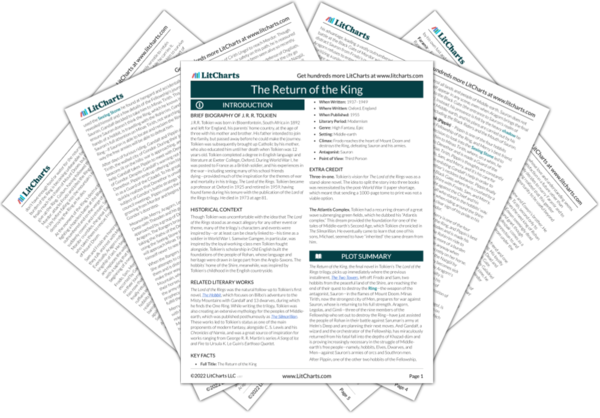Welcome to the LitCharts study guide on J. R. R. Tolkien's The Return of the King. Created by the original team behind SparkNotes, LitCharts are the world's best literature guides.
The Return of the King: Introduction
The Return of the King: Plot Summary
The Return of the King: Detailed Summary & Analysis
The Return of the King: Themes
The Return of the King: Quotes
The Return of the King: Characters
The Return of the King: Symbols
The Return of the King: Literary Devices
The Return of the King: Theme Wheel
Brief Biography of J. R. R. Tolkien

Historical Context of The Return of the King
Other Books Related to The Return of the King
Key Facts about The Return of the King
- Full Title: The Return of the King
- When Written: 1937–1949
- Where Written: Oxford, England
- When Published: 1955
- Literary Period: Modernism
- Genre: High Fantasy, Epic
- Setting: Middle-earth
- Climax: Frodo reaches the heart of Mount Doom and destroys the Ring, defeating Sauron and his armies.
- Antagonist: Sauron
- Point of View: Third Person
Extra Credit for The Return of the King
Three-in-one. Tolkien’s vision for The Lord of the Rings was as a stand-alone novel. The idea to split the story into three books was necessitated by the post-World War II paper shortage, which meant that sending a 1000-page tome to print was not a viable option.
The Atlantis Complex. Tolkien had a recurring dream of a great wave submerging green fields, which he dubbed his “Atlantis complex.” This dream provided the foundation for one of the tales of Middle-earth’s Second Age, which Tolkien chronicled in The Silmarillion. He eventually came to learn that one of his sons, Michael, seemed to have “inherited” the same dream from him.







